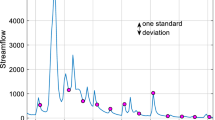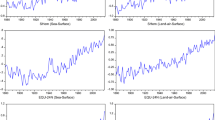Abstract
Ever since H. E. Hurst brought the concept of long memory time series to prominence in his study of river flows the origins of the so-called Hurst phenomena have remained elusive. Two sets of competing models have been proposed. The fractional Gaussian noises and their discrete time counter-part, the fractionally integrated processes, possess genuine long memory in the sense that the present state of a system has a temporal dependence on all past states. The alternative to these genuine long memory models are models which are non-stationary in the mean but for physical reasons are constrained to lie in a bounded range, hence on visual inspection appear to be stationary. In these models the long memory is merely an artifact of the method of analysis. There are now a growing number of millenial scale temperature reconstructions available. In this paper we present a new way of looking at long memory in these reconstructions and proxies, which gives support to them being described by the non-stationary models. The implications for climatic change are that the temperature time series are not mean reverting. There is no evidence to support the idea that the observed rise in global temperatures are a natural fluctuation which will reverse in the near future.
Similar content being viewed by others
References
Abry P, Veitch D (1998) Wavelet analysis of long-range-dependent traffic. IEEE Trans Inf Theory 44(1):2–15
Abry P, Veitch D, Flandrin P (1998) Long-range dependence: revisiting aggregation with wavelets. J Time Ser Anal 19(3):253–266
Allen MR, Smith LA (1994) Investigating the origin and significance of low-frequency modes of climate variability. Geophys Res Lett 21(10):883–886
Baillie RT, Chung S-K (2002) Modeling and forecasting from trend-stationary long memory models with applications to climatology. Int J Forecast 18:215–226
Beran J (1992) A Goodness-of-fit test for time series with long range dependence. J R Stat Soc B 54(3):749–760
Beran J (1994) Statistics for long memory processes. Chapman & Hall/CRC Press
Beran J, Terrin N (1996) Testing for a change in the long-memory parameter. Biometrika 83(3):627–638
Beran J, Terrin N (1999) Testing for a change in the long-memory parameter. Biometrika 86(1):233
Beran J, Whitcher B, Maechler M (2006) Longmemo: statistics for long-memory processes (Jan Beran)—data and functions. R package version 0.9-3
Bloomfield P (1992) Trends in global temperature. Clim Change 21:1–16
Bloomfield P, Nychka D (1992) Climate spectra and detecting climate change. Clim Change 21:275–287
Briffa KR, Jones PD, Wigley TML, Picher JR, Ballie MGL (1992) Fennoscandian summers from 500AD: temperature changes on short and long timescales. Clim Dyn 7:111–119
Brown RL, Durbin J, Evans J (1975) Techniques for testing the constancy of regression relationships over time. J R Stat Soc Ser B 37(2):149–192
Cappelli C, Penny RN, Rea WS, Reale M (2008) Detecting multiple mean breaks at unknown points with Atheoretical Regression Trees. Math Comput Simul 78(2–3):351–356
Chuine I, Yiou P, Viovy N, Seguin B, Daux V, Ladurie ELR (2004) Grape ripening as a past climate indicator. Nature 432(7015):289–290
Cook ER, Buckley BM, D’Arrigo RD, Peterson MJ (2000) Warm-season temperatures since 1600BC reconstructed from Tasmanian tree rings and their relationship to large-scale sea surface temperature anomalies. Clim Dyn 16:79–91
D’Arrigo R, Wilson R, Jacoby G (2006) On the long-term context for late twentieth century warming. J Geophys Res 111. doi:10.1029/2005JD006352
Deo RS, Chen WW (2000) On the integral of the squared periodogram. Stoch Process Their Appl 85:159–176
Doukhan P, Oppenheim G, Taqqu M (2003) Theory and applications of long-range dependence. Birkhaüser
Embrechts P, Maejima M (2002) Selfsimilar processes. Princeton University Press
Fisher DA, Koerner RM, Kuiviner K, Clausen HB, Johnsen SJ, Steffensen J-P, Gundestrup N, Hammer CU (1996) Intercomparison of ice core and precipitation records from sites in Canada and Greenland over the last few centuries using EOF techniques. In: Jones PD, Bradley RS, Jouzel J (eds) Climatic variations and forcing mechanisms of the last 2000 years, NATO ASI series, vol 41. Springer
Fraley C, Leisch F, Maechler M, Reisen V, Lemonte A (2006) fracdiff: fractionally differenced ARIMA aka ARFIMA(p,d,q) models. R package version 1.3-0
Geweke J, Porter-Hudak S (1983) The estimation and application of long memory time series models. J Time Ser Anal 4:221–237
Gil-Alana LA (2005) Statistical modeling of the temperatures in the northern hemisphere using fractional integration techniques. J Climate 18(24):5357–5370
Gipp MR (2001) Interpretation of climate dynamics from phase space portraits: is the climate strange or just different? Paleoceanography 16(4):335–351
Granger CWJ, Joyeux R (1980). An introduction to long-range time series models and fractional differencing. J Time Ser Anal 1:15–30
Hantemirov RM, Shiyatov SG (2002) A continuous multimillenial ring-width chronology in Yamal, northwestern Siberia. The Holocene 12(6):717–726
Haslett J, Raftery AE (1989) Space-time modelling with long-memory dependence: assessing Ireland’s wind power resource (with discussion). Appl Stat 38(1):1–50
Higuchi T (1988) Approach to an irregular time series on the basis of fractal theory. Physica D 31:277–283
Hosking JRM (1981) Fractional differencing. Biometrika 68(1):165–176
Hurst HE (1951) Long-term storage capacity of reservoirs. Trans Am Soc Civ Eng 116:770–808
Jensen MJ (1999) Using wavelets to obtain a consistent ordinary least square estimator of the long-memory parameter. J Forecast 18:17–32
Jones PD, Mann ME (2004) Climate over the past Millennia. Rev Geophys 42:1–42 RG2002
Klemes V (1974) The Hurst phenomenon—a puzzle? Water Resour Res 10(4):675–688
Mandelbrot BB, van Ness JW (1968) Fractional brownian motions, fractional noises and applications. SIAM Rev 10(4):422–437
Mandelbrot BB, Wallis JR (1969) Global dependence in geophysical records. Water Resour Res 5:321–340
Mann ME, Bradley RS, Hughes MK (1998) Global-scale temperature patterns and climate forcing over the past six centuries. Nature 392:779–787
Mann ME, Lees JM (1996) Robust estimation of background noise and signal detection in climatic time series. Clim Change 33:409–445
Milhoj A (1981) The test of fit in time series models. Biometrika 68(1):177–188
Mills T (2007) Time series modelling of two millenia of northern hemispere temperatures: long memory or shifting trends? J R Stat Soc Ser A 170:83–94
Moberg A, Sonechkin DM, Holmgren K, Datsenko NM, Karlen W (2005) Highly variable Northern Hemispere temperatures reconstructed from low- and high-resolution proxy data. Nature 433:613–617
Moore JJ, Hughen KA, Miller GH, Overpeck JT (2001) Little ice age recorded in summer temperatures from varved sediments of Donard Lake, Baffin Island, Canada. J Paleolimnol 25:503–517
Ohanissian A, Russell JR, Tsay RS (2008) True or spurious long memory? A new test. J Bus Econ Stat 26(2):161–175
Overland JE, Percival DB, Mofjeld HO (2006) Regime shifts and red noise in the North Pacific. Deep-sea Res Part 1 53:582–588
Palma W (2007) Long-memory time series theory and methods. Wiley-Interscience
Peng CK, Buldyrev SV, Simons M, Stanley HE, Goldberger AL (1994) Mosaic organization of DNA nucleotides. Phys Rev E 49:1685–1689
R Development Core Team (2005) R: a language and environment for statistical computing. R Foundation for Statistical Computing, Vienna, Austria. ISBN 3-900051-07-0
Ripley B (2005) Tree: classification and regression trees. R package version 1.0-19
Robinson PM (2003) Time series with long memory. Oxford University Press
Salzer MW, Kipfmueller KF (2005) Reconstructed temperature and precipitation on a millennial timescale from tree-rings in the Southern Colorado Plateau, USA. Clim Change 70:465–487
Sibbertsen P (2004) Long memory versus structural breaks: an overview. Stat Pap 45(4):465–515
Smith AD (2005) Level shift and the illusion of long memory in economic time series. J Bus Econ Stat 23(3):321–335
Smith RL, Wigley TML, Santer BD (2003) A bivariate time series approach to anthropogenic trend detection in hemispheric mean temperatures. J Climate 16(8):1228–1240
Stephenson DB, Pavan V, Bojariu R (2000) Is the North Atlantic oscillation a random walk? Int J Climatol 20:1–18
Tan M, Liu TS, Hou J, Qin X, Zhang H, Li T (2001) 2650-year Beijing Stalagmite Layer Thickness and Temperature Reconstruction IGBP PAGES/World Data Center for Paleoclimatology Data Contribution Series No. 2003-050
Taqqu M, Teverovsky V, Willinger W (1995) Estimators for long-range dependence: an empirical study. Fractals 3(4):785–798
Teverovsky V, Taqqu M (1999) Testing for long-range dependence in the presence of shifting means or a slowly declining trend, using a variance-type estimator. J Time Ser Anal 18(3):279–304
Thomson DJ (1990) Time series analysis of Holocene climate data. Philos Trans R Soc Lond A 330:601–616
Veitch D, Abry P (1999) A wavelet-based joint estimator of the parameters of long-range dependence. IEEE Trans Inf Theory 45(3):878–897
Wuertz D (2005a) fBasics: financial software collection—fBasics. R package version 220.10063
Wuertz D (2005b) fSeries: financial software collection. R package version 220.10063
Zeileis A, Leisch F, Hornik K, Kleiber C (2002) strucchange: an R package for testing for structural change in linear regression models. J Stat Softw 7(2):1–38
Author information
Authors and Affiliations
Corresponding author
Rights and permissions
About this article
Cite this article
Rea, W., Reale, M. & Brown, J. Long memory in temperature reconstructions. Climatic Change 107, 247–265 (2011). https://doi.org/10.1007/s10584-011-0068-y
Received:
Accepted:
Published:
Issue Date:
DOI: https://doi.org/10.1007/s10584-011-0068-y




